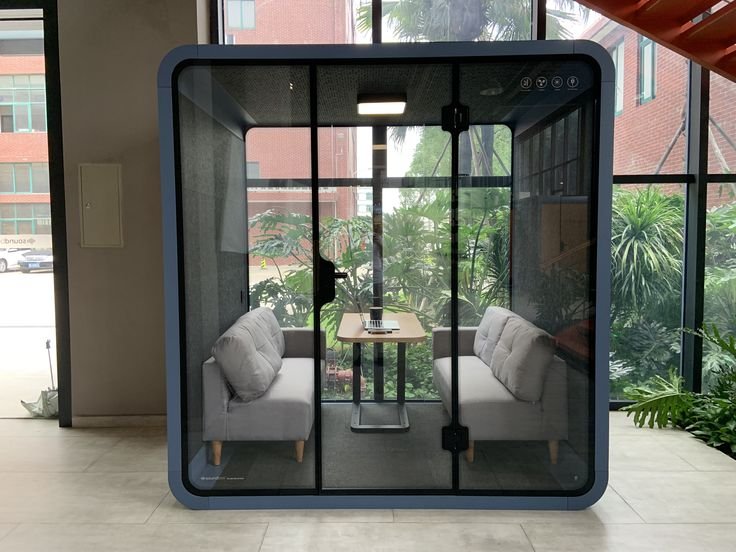Portable acoustic booths or Insulation pods are enclosed structures designed to provide soundproofing and insulation in various settings. They are commonly used in environments where noise reduction, privacy, or controlled acoustic conditions are required. These pods are versatile and can be used in both residential and commercial spaces.
Construction and Design
Insulation pods are typically constructed using materials that offer excellent sound absorption and insulation properties. The outer walls are made of sturdy materials like high-density fiberboard (HDF), plywood, or metal panels, which help to block external noise. The interior walls of the booth are lined with sound-absorbing materials such as acoustic foam, mineral wool, or fiberglass insulation. These materials absorb sound waves and prevent them from bouncing back into the space.The pods are often designed with an airtight seal to minimize sound leakage. They may have double-walled construction with an air gap between the walls to enhance sound insulation. The doors of the booth are also designed to be soundproof, usually with heavy-duty seals and multiple layers of insulation.
Soundproofing Features
The primary purpose of insulation pods or acoustic booths is to provide soundproofing. They are equipped with various features to achieve this goal:
- Sound-absorbing materials: The interior walls and ceiling of the pod are lined with acoustic materials that absorb sound waves, reducing echoes and reverberations.
- Decoupling: To further enhance soundproofing, the booth’s structure is often isolated from the surrounding environment. This decoupling prevents vibrations or sound transmission through the floor or walls.
- Sealing: The joints, seams, and edges of the booth are carefully sealed to prevent sound leakage. Special attention is given to the door, ensuring it closes tightly and forms an airtight seal.
- Ventilation: Insulation pods also incorporate ventilation systems that maintain a comfortable environment while minimizing external noise intrusion. These systems often use acoustic baffles or duct silencers to reduce noise transmission.
Applications
- Recording studios: These booths are commonly used in professional recording studios to create an isolated and controlled environment for recording vocals or musical instruments.
- Home offices: With the rise of remote work, individuals often require a quiet space to focus and eliminate distractions. Portable acoustic booths can be set up in homes to create a dedicated workspace with reduced noise interference.
- Call centers: In busy call centers or offices, insulation pods provide a quiet area for employees to make phone calls or engage in private conversations, ensuring privacy and minimizing background noise.
- Trade shows and exhibitions: Portable acoustic booths are used to create enclosed spaces within large exhibition halls, allowing exhibitors to showcase products or services while reducing ambient noise.
- Medical facilities: Insulation pods can be found in hospitals, clinics, and dental offices to create soundproofed examination or treatment rooms, maintaining patient confidentiality and reducing external noise disturbances.
Benefits
Insulation pods and portable acoustic booths offer several advantages:
- Noise reduction: The primary benefit of these structures is their ability to reduce noise levels. They create a controlled acoustic environment, minimizing external noise and providing sound insulation.
- Versatility and portability: Portable acoustic booths are designed for easy installation and dismantling, making them highly versatile. They can be moved or reconfigured to accommodate changing needs or spaces.
- Privacy and concentration: These booths offer privacy for conversations or activities that require concentration, making them ideal for office spaces, educational institutions, or even personal use.
- Aesthetics: Insulation pods are available in various sizes and designs, allowing customization to match the surrounding environment. They can be

